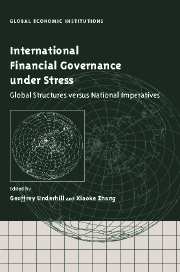Book contents
- Frontmatter
- Contents
- List of figures
- List of tables
- List of contributors
- Acknowledgements
- Introduction: global market integration, financial crises and policy imperatives
- I Financial globalisation and policy responses: concepts and arguments
- II Globalisation, financial crises and national experiences
- III Private interests, private–public interactions and financial policy
- IV Building the new financial architecture: norms, institutions and governance
- 15 The legitimacy of international organisations and the future of global governance
- 16 The G-7 and architecture debates: norms, authority and global financial governance
- 17 Bail-outs, bail-ins, and bankruptcy: evolution of the new architecture
- Conclusion: towards the good governance of the international financial system
- Index
17 - Bail-outs, bail-ins, and bankruptcy: evolution of the new architecture
Published online by Cambridge University Press: 22 September 2009
- Frontmatter
- Contents
- List of figures
- List of tables
- List of contributors
- Acknowledgements
- Introduction: global market integration, financial crises and policy imperatives
- I Financial globalisation and policy responses: concepts and arguments
- II Globalisation, financial crises and national experiences
- III Private interests, private–public interactions and financial policy
- IV Building the new financial architecture: norms, institutions and governance
- 15 The legitimacy of international organisations and the future of global governance
- 16 The G-7 and architecture debates: norms, authority and global financial governance
- 17 Bail-outs, bail-ins, and bankruptcy: evolution of the new architecture
- Conclusion: towards the good governance of the international financial system
- Index
Summary
The problem is that we have no accepted framework in which a country in extremis can impose a payments suspension or standstill pending agreement with its creditors … [This is] compounded by the absence of an accepted legal framework in which the debtor and its creditors can work to seek to restore viability.
Stanley FischerLegal and institutional aspects of global economic governance, particularly the management and resolution of financial crises, are the focus of this chapter. To avoid ever-larger public sector bail-outs (and their adverse incentive effects), increased involvement of private bankers and investors in resolving sovereign debt crises is called for. In the short term this may be achieved by standstills and other ‘bail-in’ devices such as forced roll-overs, collective action clauses and bond swaps. In the longer term, however, an International Bankruptcy Procedure accompanied by private arrangements for contingent credit provision and debt restructuring will probably be required.
We begin with an interesting historical precedent. When the United States left the Gold Standard in 1933, the dollar price of gold rose by almost 70 per cent and the Gold Indexation Clause embedded in most private long-term debt contracts – and in much of the public debt – mandated a matching increase in the dollar value of debt. To prevent a credit crunch, President Roosevelt secured a resolution of Congress suspending the Gold Clause; but this was challenged by creditors going to the law, all the way to the Supreme Court.
- Type
- Chapter
- Information
- International Financial Governance under StressGlobal Structures versus National Imperatives, pp. 343 - 359Publisher: Cambridge University PressPrint publication year: 2003



